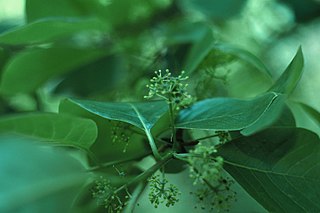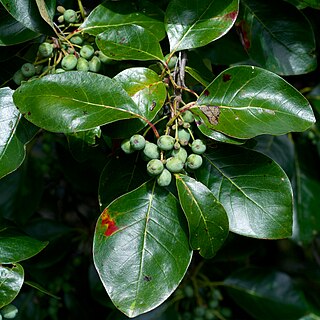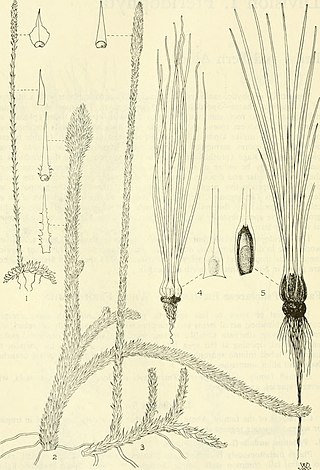
Isoetes, commonly known as the quillworts, is a genus of lycopod. It is the only living genus in the family Isoetaceae and order Isoetales. There are currently 192 recognized species, with a cosmopolitan distribution mostly in aquatic habitats but with the individual species often scarce to rare. Some botanists split the genus, separating two South American species into the genus Stylites, although molecular data place these species among other species of Isoetes, so that Stylites does not warrant taxonomic recognition. Species virtually identical to modern quillworts have existed since the Jurassic epoch, though the timing of the origin of modern Isoetes is subject to considerable uncertainty.

Tupelo, genus Nyssa, is a small genus of deciduous trees with alternate, simple leaves. It is sometimes included in the subfamily Nyssoideae of the dogwood family, Cornaceae, but is placed by other authorities in the family Nyssaceae. In the APG IV system, it is placed in Nyssaceae.

Nyssa sylvatica, commonly known as tupelo, black tupelo, black gum or sour gum, is a medium-sized deciduous tree native to eastern North America from the coastal Northeastern United States and southern Ontario south to central Florida and eastern Texas, as well as Mexico.

Vernal pools, also called vernal ponds or ephemeral pools, are seasonal pools of water that provide habitat for distinctive plants and animals. They are considered to be a distinctive type of wetland usually devoid of fish, and thus allow the safe development of natal amphibian and insect species unable to withstand competition or predation by fish. Certain tropical fish lineages have however adapted to this habitat specifically.

Isoetes lacustris, the lake quillwort or Merlin's grass, is a boreal quillwort native on both sides of the northern Atlantic Ocean. Synonyms include Isoetes hieroglyphica.

The frosted flatwoods salamander is an endangered salamander species native to the Southeastern United States.

Nyssa aquatica, commonly called the water tupelo, cottongum, wild olive, large tupelo, tupelo-gum, or water-gum, is a large, long-lived tree in the tupelo genus (Nyssa) that grows in swamps and floodplains in the Southeastern United States.

Isoetes tegetiformans, commonly known as mat-forming quillwort or mat-forming Merlin's grass, is an aquatic lycophyte endemic to the U.S. state of Georgia. It grows exclusively in shallow, temporary pools on granite outcrops, often with only 2 cm of soil. Only 7 populations are known to exist, and three of these have been destroyed since the plant's discovery in 1976. The remaining populations are threatened with habitat destruction due to quarrying, though the species is protected under the U.S. Endangered Species Act. New leaves quickly sprout after fall and winter rains, but during the dry summer months these typically shrivel.

Isoetes melanospora, commonly known as black-spored quillwort or black-spored Merlin's grass, is a rare and endangered aquatic lycophyte endemic to the U.S. states of Georgia and South Carolina.
Bogue Chitto National Wildlife Refuge is located 60 mi (97 km) northeast of New Orleans, Louisiana, U.S., and encompasses 36,000 acres (150 km2) of Pearl River Basin swampland.

Cat Island National Wildlife Refuge was established on October 27, 2000, as the 526th refuge in the United States National Wildlife Refuge System. It is located near the town of St. Francisville, Louisiana, which is 30 miles (48 km) north of Baton Rouge. The refuge was established to conserve, restore, and manage native forested wetland habitats for migratory birds, aquatic resources, and endangered and threatened plants and animals. Additionally, it was created to encourage the use of volunteers and facilitate partnerships among the U.S. Fish and Wildlife Service, local communities, and conservation organizations to promote public awareness of resources of the refuge and the National Wildlife Refuge System.

Coniferous swamps are forested wetlands in which the dominant trees are lowland conifers such as northern white cedar. The soil in these swamp areas is typically saturated for most of the growing season and is occasionally inundated by seasonal storms or by winter snow melt.

Scirpus ancistrochaetus is a rare species of flowering plant in the sedge family known by the common names barbedbristle bulrush and northeastern bulrush. It is native to the northeastern United States from New Hampshire south to Virginia. It used to be found in Quebec but it is now thought to be extirpated there. It was also believed extirpated from the state of New York, but at least one population has been rediscovered in Steuben County in 2010. It is threatened by the loss and degradation of its wetland habitat. It is a federally listed endangered species.

Nyssa biflora, commonly referred to as the swamp tupelo, or swamp black-gum is a species of tupelo that lives in wetland habitats. Swamp tupelo grows chiefly in the coastal plains from Delaware, eastern Maryland, and southeastern Virginia, south to southern Florida and west to eastern Texas. Its range extends north up the Mississippi Valley to southern Arkansas and west and south Tennessee.

Nyssa ogeche, commonly referred to as Ogeechee tupelo, white tupelo, river lime, ogeechee lime tree, sour gum or wild lime is a deciduous tree. Growing to 15 m, it is in flower from March to May, and the seeds ripen from August to October. The flowers are pollinated by bees. It is noted for attracting wildlife.
The southern coastal plain nonriverine cypress dome is a forested wetland community found in the southern Atlantic coastal plain, in the states of Alabama, Florida, Georgia, Louisiana, and Mississippi.

The Mississippi Alluvial Plain is a Level III ecoregion designated by the Environmental Protection Agency (EPA) in seven U.S. states, though predominantly in Arkansas, Louisiana, and Mississippi. It parallels the Mississippi River from the Midwestern United States to the Gulf of Mexico.
Pearl River Wildlife Management Area, also known as Pearl River WMA, is a 35,619 acres (14,414 ha) tract of protected area near Slidell in St. Tammany Parish, Louisiana, in the United States. The WMA is managed by the Louisiana Department of Wildlife and Fisheries (LDWF)

Isoetes melanopoda is a species of nonflowering vascular plant belonging to the quillworts in the family Isoetaceae. Its common names include: black-footed quillwort, midland quillwort, and prairie quillwort.
The Eastern Temperate Forests is a Level I ecoregion of North America designated by the Commission for Environmental Cooperation (CEC) in its North American Environmental Atlas. The region covers much of the Eastern and Midwestern United States, the U.S. Interior Highlands, and parts of Ontario, Quebec, and the Maritimes.
















